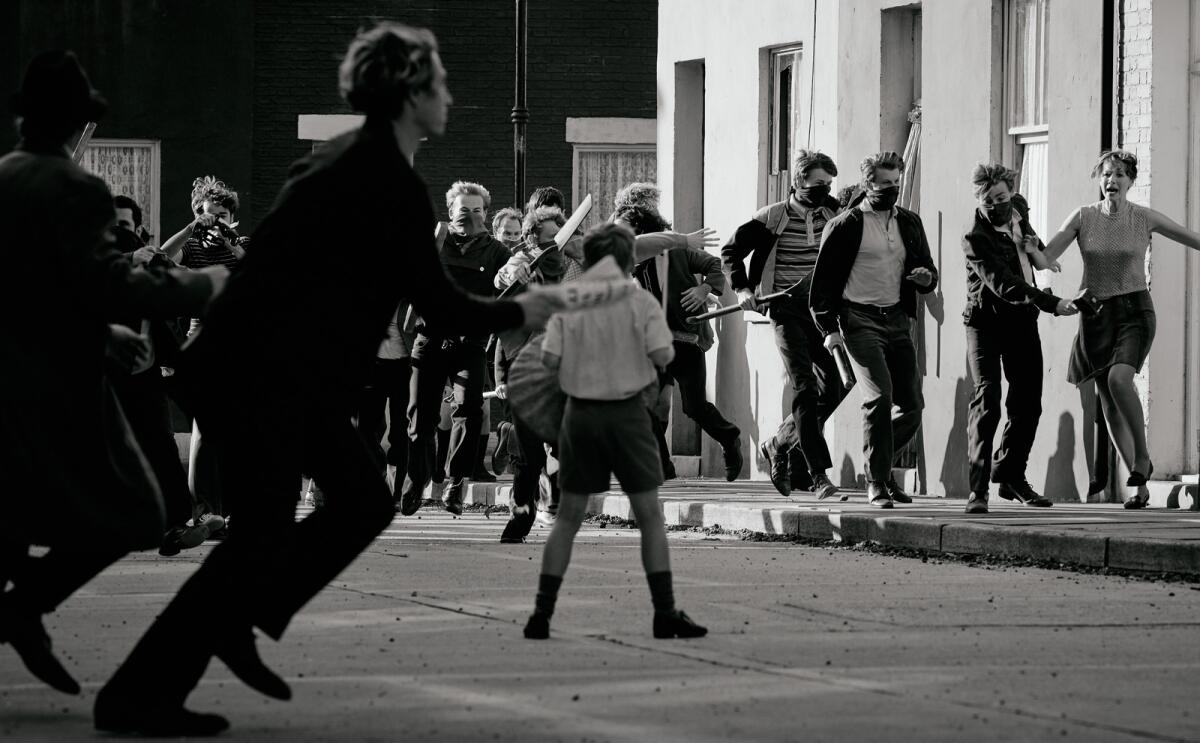How the soundscape of âBelfastâ puts the audience in the middle of a riot

When he was 9, playing in the streets of Belfast one afternoon, Kenneth Branagh thought he heard a distant swarm of buzzing bees coming from down the block. Heâd soon learn the buzz was in fact the hum of human rancor generated by rioters storming around the corner.
Fifty-one years later, âBelfastâsâ Oscar-nominated sound team re-created that crowd noise at Twickenham Film Studios in West London. âThose sessions were extraordinary,â says sound supervisor James Mather. âActors who were both Catholic and Protestant were brought into a room to hurl abuse at each other, with Ken directing and writing dialogue as he went. Rarely have I seen a crowd of actors so animated when discussing a sequence.â
Mather and re-recording mixer Niv Adiri, speaking from their homes in England, note that the âBelfastâ soundscape, created with their nominated colleagues Simon Chase and Denise Yarde, centered on a clear directive: Branaghâs young stand-in Buddy (Jude Hill) would be the center of this Northern Ireland universe. âIt was Kenâs idea that the story be presented from Buddyâs point of view whenever we could and the camera work allowed us to create a virtual world of sound around him that gave the audience an insight into his experience.â
Filmmakers shot most of âBelfastâ during COVID lockdown at a regional British airport, where a replica of Branaghâs old neighborhood had been built. Except for dialogue recorded on radio âlapelâ mics, virtually all audio elements were captured or curated far from the set. âKnowing that none of the production sounds would get in the way, we had fun building the soundtrack,â says Mather. âWe did a car being whacked, windows being broken, explosions. We recorded some nice fire by igniting flame on pre-laid petrol to get that âwhooshâ sound.â
The clanking train sounds that permeated Belfast, a busy port city, were recorded near Waterloo station in London. Droning helicopters were heard but not seen, with Adiri using Dolby Atmos audio technology to place the whirring sounds above the audience in theatersâ ceiling-mounted speakers. Mather says, âYou hear the trains and you hear helicopters but you donât have to see them to know what they are. And it saves money!â
The audio palette assembled by Mather and company plays a transformative role in the filmâs first five minutes, which go from idyllic childhood to brutal civil war in one sickening moment. âBuddyâs playing football, heâs having a laugh with the neighbors, people are calling his name â weâre setting up this street as one big family. Heâs walking down the street with this beautiful [camera] pan around him, and then we do a closeup where we isolate just him with his breath. And then the big explosion in front of him opens up the hellish sounds heâs never heard before.â
Adiri sought sonic clarity amid the chaos. âIn the riot scene, you have to clear out so much you donât need in order to focus on what Buddy would have found disturbing. It comes down to the concept of his memories and mixing in a specific sound for each shot.â
Before âBelfast,â Mather worked on two âMission: Impossibleâ movies and four âHarry Potterâ films while Adiri won an Oscar for âGravityâ and mixed the âFantastic Beastsâ franchise. Wryly described by Mather as âmega-malistâ in scope, the blockbuster aesthetic contrasts quietly with Branaghâs less-is-more concept.
Mather notes, âThereâs a sparseness to the [audio] track for âBelfast.â Where you would normally have another layer of generic atmosphere, the background sounds here are really dialed into hearing the story from Buddyâs point of view. Everything about the soundtrack was bespoke.â
Music cues in âBelfastâ drew heavily from Irish singer-songwriter Van Morrisonâs catalog of emotive Celtic soul songs, which were melded seamlessly into the mix. In a separate email interview, âBelfastâ sound supervisor-re-recording mixer Chase points out, âThe film doesnât have a score as such so we used sound design to underscore many of the movieâs emotional moments, and then the through-line of Vanâs work helped hang it all together.â
Widely considered Branaghâs most personal filmmaking effort, âBelfastâ inspired like-minded contributions from mixer Adiri. He contributed to the filmâs kids-at-play background banter by recording his own children romping in the garden. Adiri also borrowed his sonâs drum kit and recorded himself playing along to the Motown-style hit âEverlasting Love,â belted out by Jamie Dornanâs Pa character at a local dance hall. âI think our music editor found four bars that were good and maybe kept the crash cymbals, so we were able to bleed that in [to the studio recording] and make you feel like youâre right there, live, with Jamie and the band.â
During post-production, Mather and Adiri worked shoulder to shoulder with Branagh, breezing through the initial sound mix in a nearly unheard-of five days. âIt was a joyful sprint rather than a marathon of misery,â says Mather, laughing. âWhereas on âBelfast,â our shorthand with Ken really came into its own and got the film done, quickly, astutely, accurately, with the right tone, the right emotion. So often, youâre slaving away on something into the night thinking: âWell, itâs a job. Iâm singing for my dinner.â âBelfastâ wasnât about singing for your dinner. It was about singing for the joy of singing.â
More to Read
From the Oscars to the Emmys.
Get the Envelope newsletter for exclusive awards season coverage, behind-the-scenes stories from the Envelope podcast and columnist Glenn Whippâs must-read analysis.
You may occasionally receive promotional content from the Los Angeles Times.










